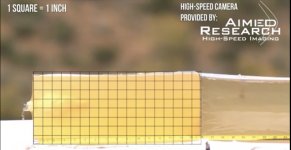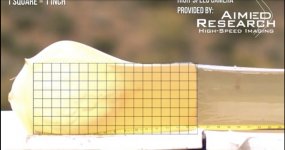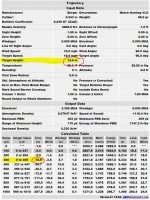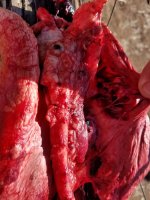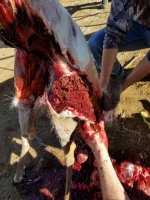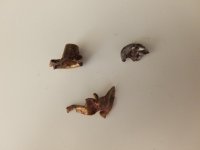While technically they’re labeling it a hunting bullet, Begers are match bullets in design and performance. Also, it’s equivalent to a 130gr 6.5. That’s not necessarily a bad thing, but a 115gr to low 120gr 6mm would put it in the 140+ grain class of 6.5’s ballistically and with that much length, penetration even with a fragmenting bullet would be excellent.
Yes, correct on the match/hunting explanation on Berger.
It's all application. On deer sized game, the 95 and 108 are plenty to get adequate penetration down to 1800 fps impact velocity. The thread on the .223 77gr TMK demonstrates that it isn't necessarily the size of the bullet, it is impact velocity and bullet construction.
You've explained as well as anyone I have heard say why "match" bullets work. As I see it, three important things to focus on whether a bullet will work are: 1) bullet construction, 2) terminal velocity, and 3) shot placement. One and two define the expected terminal performance in soft tissue. Three is whether you can put the bullet in that soft tissue. My 6mm has all three for my application.
I don't necessarily like the designation "match" bullet, because it is not a useful designation, it doesn't describe the bullet design really, but it is what manufacturers use. Describing the construction is much better, because that is what matters for the type of terminal performance to be expected.
The choice in the 6mm illustrates why there can be different choices--and why sometimes the differences just don't matter beyond internet forums if a guy pokes a hole in an animal under the proper parameters.
The difference in drop between the published factory speeds on the Berger loaded 140 grain 6.5 cm ammo out of a 26" barrel and my baby 6mm BRA running 108 or 95 are within inches of the 6.5 at the same environmental data out to 800. All three are still barely above 1800 fps to 800 yards, but not much more than that. The drop of 108 is 163 inches, the 95 is 148, and the 6.5 cm falls between them at 152. For, wind drift the 6.5 beats the lighter 95 by 8ish inches because of the extra weight and BC of the 6.5. Full disclosure, my 6 BRA data is based off of the best I can guestimate for 22" barreled based off other data found on the interwebs and extrapolating velocity loss with a shorter barrel than typically run on 6BRA target rifles. Sure, you can shoot a shorter barreled 6 prc with 140 and it is a hammer, but you get a lot more recoil than my 6 bra.
Velocity makes up for BC inside 500 yards between the 6 bra and 6.5 cm. My 95 with much worse BC has 1 inch less drop than the 6.5 creedmoor, so it beats it inside 500 for drop. On the flip side, the 95 has 1.2 inches more wind drift than the 140, so the 6.5 cm beats it in wind approaching 500 yards. Most shots are going to be inside 500. And, I can dial for the extra 10 inches of drop at 800 easily. I don't feel like the difference in wind will hurt me that much between 500 and 800, but I do have to give it to the 6.5 for better wind drift numbers.
The practical difference for me is that the 6mm 95 and 108 can be run at about 3000 to 2850 fps respectively and still be above expansion velocity out to 800 yards and fit into a customized mini action Howa-making for a short, compact, ultralight backpack rifle that is super easy to shoot with significantly less recoil than an already easy to shoot 6.5 cm. When you are in hunting situations, having reduced recoil makes for better shooting, especially off tripods. I won't even need a brake to spot shots and watch trace, it will be like shooting a braked 6.5 CM.
That was all based off of the 6 BRA which has significantly less case capacity than the 6 creedmoor. If I shot the 108 or 115 out of the 6 creedmoor or 6xc at 3000 fps or above, it smokes the 6.5 creedmoor. I like to think of the 6 creedmoor/XC/243 like the "magnum" equivalent of the 6.5 PRC (roughly speaking), because that is where you have to go in case capacity in 6.5 to get back to the velocity to out compete the 115 ballistically. It's all relative though, and it is so close that it isn't worth arguing over, but I do love to get into the technical weeds.
At 800 yards, my 7 mag with 180 vld is still over 2000 fps and has about 20 inches less drop with 15 inches less drift than the 6.5 cm. It is still beating it out to 950 yards and remains over 1800 fps to 1000 yards.
I say the reason to go with a bigger caliber is to make a bigger and deeper wound channel for terminal performance on bigger animals and to get less wind drift in external ballistics. Another reason is related, to get more penetration for bad angles on those animals, through heavier bone. Its why I shoot a 7mm 180 vld for elk, bear and caribou, even though a 6mm would kill an elk with a broadside shot. Like I chose the 6mm, I chose the 7mm 180 vld because it is maximized for drop and wind drift at the hunting ranges (I am comfortable shooting out to 800-900 maybe) without the diminishing returns of recoil of a ballistically better ultra mag 7 or .300 with heavier bullets and more powder. It does a satisfying job on caribou and elk by my personal experience. It is far more than enough for deer, which is why I ran the numbers for my typical situation and came to the conclusions I did about going with a 6mm bullet as described above.
Admittedly, I am a sissy, I don't like recoil or muzzle blast, hahahaha, but really, I just choose an adequate cartridge that met my criteria for the purposes. I haven't felt the need to go bigger for "insurance" purposes. Feel free to judge me for that, lol. But, in the end, I am comfortable knowing where I can put a "match" hunting bullet, and that is good enough for me.
